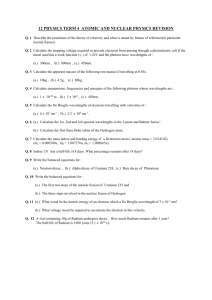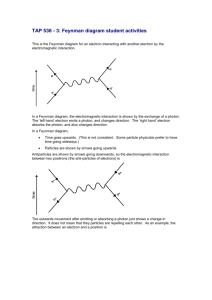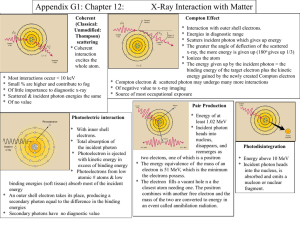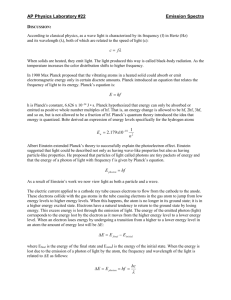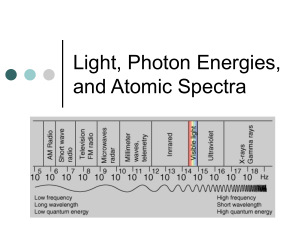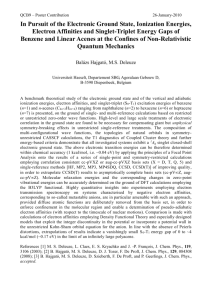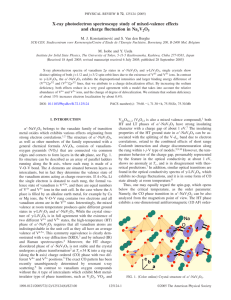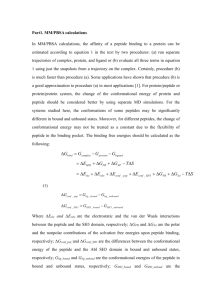Level 3 Physics (90522) 2010 Assessment Schedule
advertisement
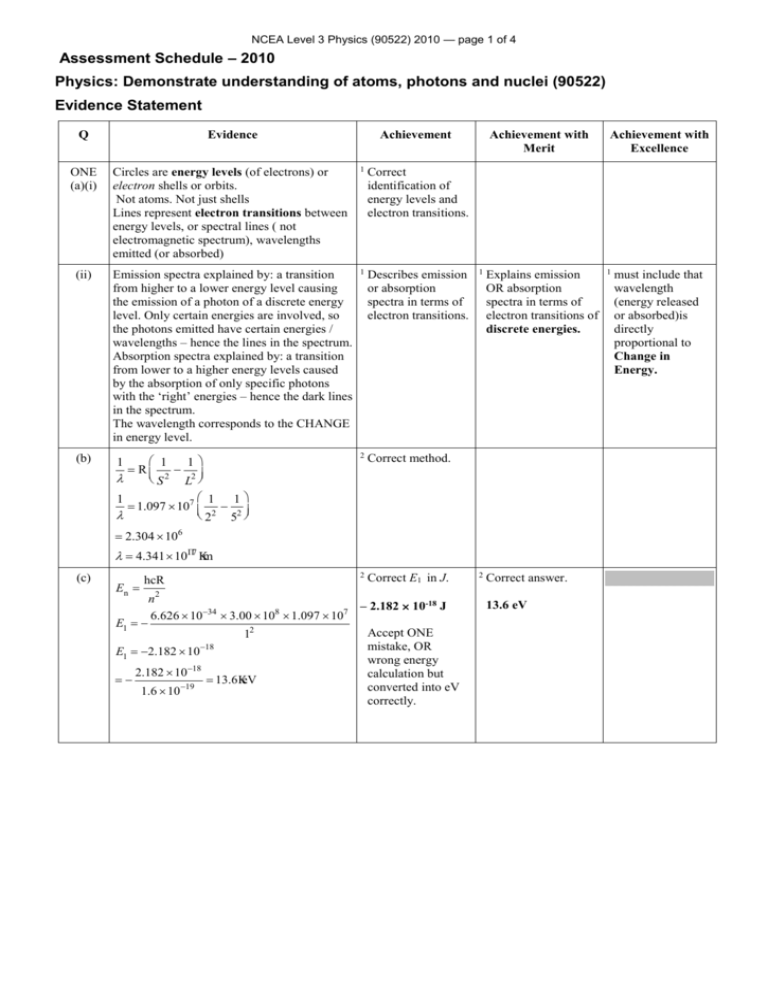
NCEA Level 3 Physics (90522) 2010 — page 1 of 4 Assessment Schedule – 2010 Physics: Demonstrate understanding of atoms, photons and nuclei (90522) Evidence Statement Q Evidence ONE (a)(i) Circles are energy levels (of electrons) or electron shells or orbits. Not atoms. Not just shells Lines represent electron transitions between energy levels, or spectral lines ( not electromagnetic spectrum), wavelengths emitted (or absorbed) 1 Correct identification of energy levels and electron transitions. (ii) Emission spectra explained by: a transition from higher to a lower energy level causing the emission of a photon of a discrete energy level. Only certain energies are involved, so the photons emitted have certain energies / wavelengths – hence the lines in the spectrum. Absorption spectra explained by: a transition from lower to a higher energy levels caused by the absorption of only specific photons with the ‘right’ energies – hence the dark lines in the spectrum. The wavelength corresponds to the CHANGE in energy level. 1 Describes emission or absorption spectra in terms of electron transitions. (b) 1 1 R 2 2 S L 1 1 1 1.097 107 2 2 2 5 2 Correct method. 2 Correct E1 in J. 1 Achievement Achievement with Merit 1 Explains emission OR absorption spectra in terms of electron transitions of discrete energies. 2 Correct answer. 2.304 106 4.341 10Π7 Κm (c) En hcR 2 n – 2.182 10-18 J 6.626 1034 3.00 108 1.097 107 E1 Accept ONE 12 18 mistake, OR E1 2.182 10 wrong energy 2.182 1018 calculation but 13.6ΚeV 19 converted into eV 1.6 10 correctly. 13.6 eV Achievement with Excellence 1 must include that wavelength (energy released or absorbed)is directly proportional to Change in Energy. NCEA Level 3 Physics (90522) 2010 — page 2 of 4 (d) 2 1 1 1.097 10 2 2 8.2275 106 1 1 OrΚusesΚvalueΚgiven,Κ122Κnm hc E hf 1 7 Converts into J 3.66 1.6 10 6.626 1034 3.00 108 8.2275 106 1.635 1018 ΚJ hf EK EK hf EK 1.635 1018 3.66 1.6 1019 EK 1.04 1.6 10 18 19 5.86 1019 ΚJ OR frequency calculated correctly. f = 2.47 1015 Hz 2 2 Correct calculation of photon energy. Complete answer. = 1.635 10 –18 J = 1.04 10–18 J = 1.05 10–18 J Or in eV = 10 eV ΚJ OrΚusesΚvaluesΚgiven,122Κnm hc E hf 6.626 1034 3.00 108 1.22 109 1.629 1018 ΚJ hf EK EK hf EK 1.629 1018 3.66 1.6 1019 EK 1.04 1018 ΚJ Also accept 1.05 10–18 J TWO (a) E hf hc hc 6.626 1034 3.00 108 E 4.97 1019 4.00 107 Κm 2 Correct frequency of E hf 2 400 nm = 4.00 10–7 m E h 4.97 1019 f 6.626 1034 7.5 1014 ΚHz (b) (c) Photo electric effect: Threshold frequency – there is no emission of electrons when the surface is illuminated with light below a threshold frequency, however intense this light is. This suggests that the light is interacting with the surface in discrete amounts of energy. If the energy of this photon is too low then no electron emission can occur. Photo electric effect: No time delay at low light intensity. There is no evidence the energy is spread out at low energies because electron emission begins immediately. This agrees with a 1 photon = 1 electron emission model. Blackbody radiation answers are also acceptable. EK eV 1.6 1019 10 103 1.6 1015 ΚJ Mentions photoelectric effect OR loosely describes Photoelectric effect. 2 Correct answer. 1 Mentions threshold frequency or no time delay in photo electric effect. 1 Complete answer explaining either why threshold frequency or no time delay means that light energy is quantised. NCEA Level 3 Physics (90522) 2010 — page 3 of 4 (d) Ephoton hf 6.626 10 V 2 hc 34 3.00 108 2.36 109 8.423 10 17 2 Calculation of photon energy. 2 Correct answer. 526 V or 527 V = 8.423 10–17J Ek 8.4231017 526ΚV e 1.6 1019 The electrons must have energy equal to (or greater than) that of the photon (all the electron energy can be released as a photon). m 66.34446 1027 THREE (a) frequency calculated correctly. f = 1.27 1017 Hz 1 Correct assumption. Do not accept work function is negligible or conservation of energy. 2 Correct mass deficit. 66.34121 1027 2 Correct answer. = 2.339 10–30 kg = 2.1 10–13 J Binding energy is the energy required to completely separate the nucleons in a nucleus. Ca must be at a lower energy, because energy was given off when the reaction happened. So Ca must have a greater binding energy. Both nuclei have the same number of nucleons, so the Ca has the greater binding energy per nucleon. OR Fe is the most stable nucleus (A), and an excellence level explanation to compliment answer can gain full marks 1 Recognition that Ca has a greater binding energy. OR correct definition of binding energy. OR that the nuclei have the same number of nucleons. OR Fe 1 6.626 1034 3.00 108 2 Correct calculation. 1 Correct answer can be used to demonstrate concept knowledge 0.000911 1027 2.339 1030 Κkg E mc 2 E 2.339 1030 3.00 108 2 2.1 1013 ΚJ (b) (c) E hc 8.5 1013 2.339 1013 ΚJ This is more than the energy release in the reaction so it can’t have come from it. OR using Energy from part (a) to find λ (9.45 10–13), and comparing λ (8.5 10–13), Correct definition of Binding energy + Recognition that Ca has the greater binding energy per nucleon because • more mass deficit • Ca has less mass • Ca is formed spontaneously • energy is given out. 1 Ca has more binding energy, but same number of nucleons, so more binding energy per nucleon. NCEA Level 3 Physics (90522) 2010 — page 4 of 4 Judgement Statement Achievement Achievement with Merit C1 2 A1 1 A1 + 2 M1 C2 3 A2 2 A2 + 3 M2 Achievement with Excellence 3 E, including at least one from each criterion + 1 M1 and 1 M2
